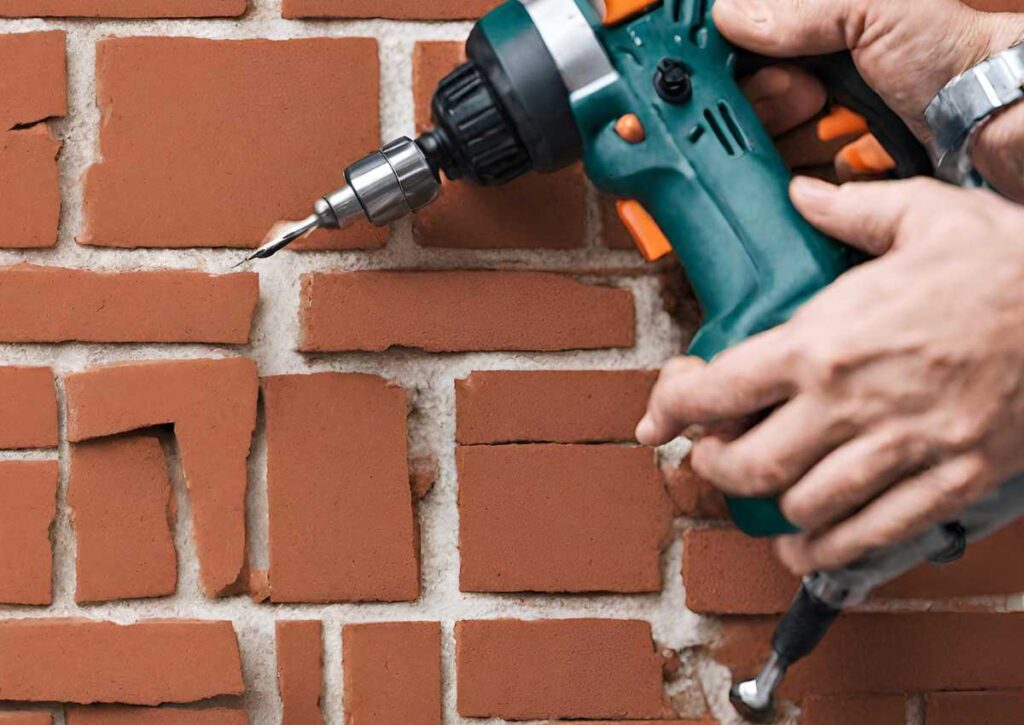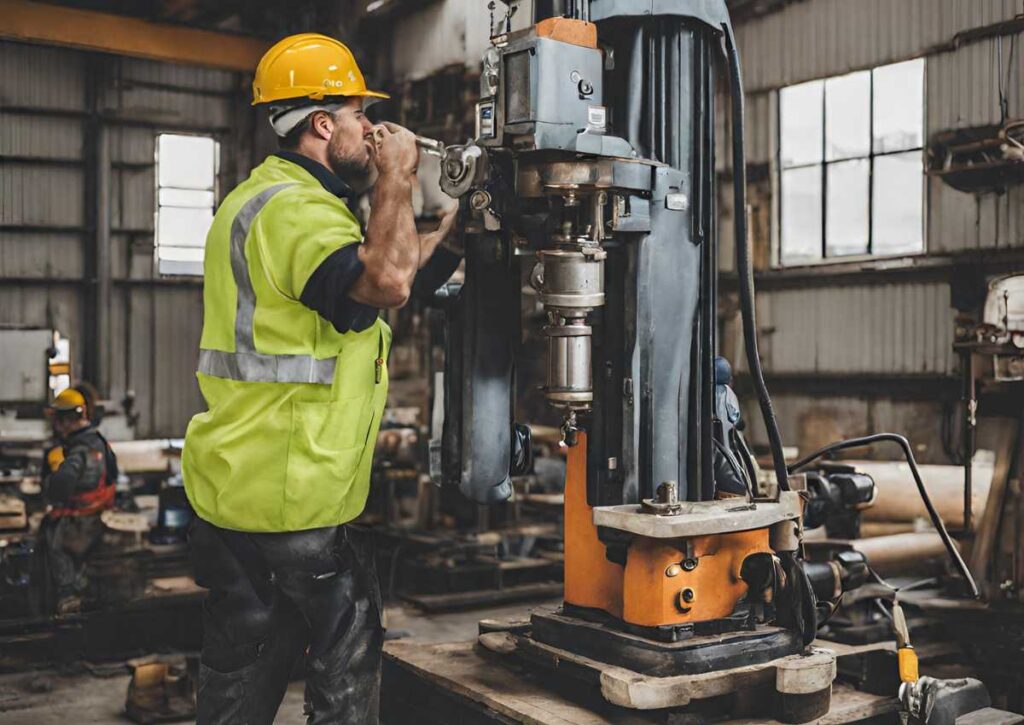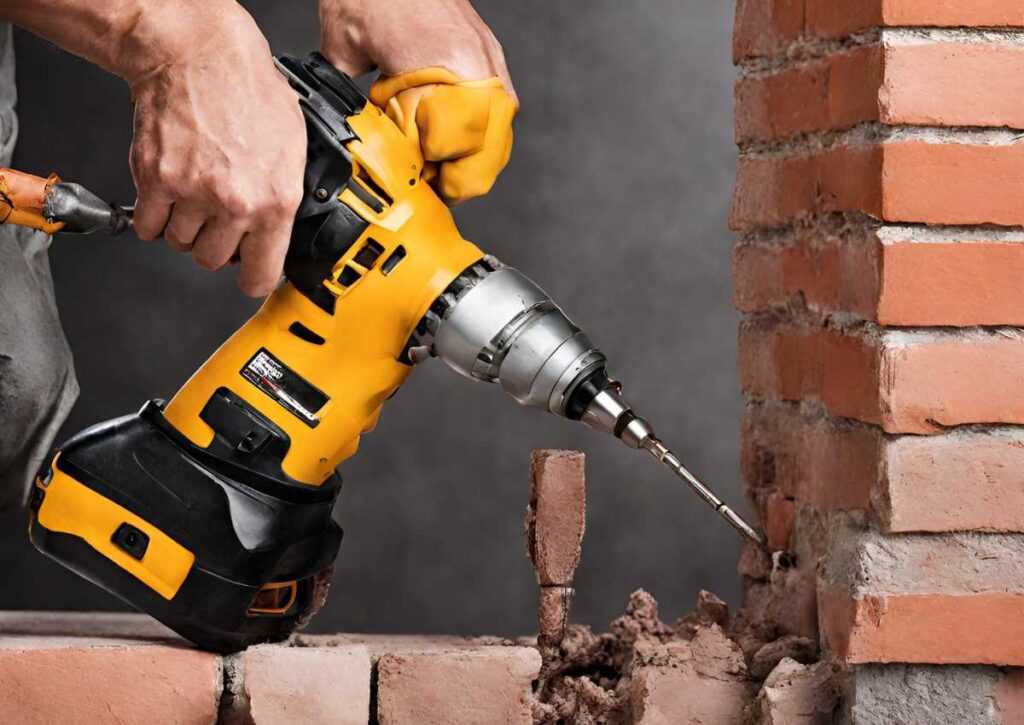Have you ever attempted to hang a picture frame or install a shelf on a brick wall only to be dissatisfied with the difficulty of drilling into it?
You’re not alone. Brick walls can be challenging, but you can do the job with the right tools and techniques.
We’ll show you how to drill into brick like a pro so you can confidently tackle your DIY projects.
How to Drill Into Brick in 6 Easy Steps: To drill into brick, use a masonry bit and a drill with a hammer function.
Mark the spot with a pencil and drill slowly, using water to keep the bit cool. Once you’ve dug deep enough, insert an anchor and screw it into place.
Whether you’re a seasoned DIYer or a beginner, this Guide will give you the tips and tricks you need to succeed.
Necessary Tools and Materials
When drilling into brick, having the right tools and materials is essential to ensuring a successful and safe outcome.
Brick is a strong material, but it can be hard to drill into without the right tools.
Whether hanging a picture frame, installing a shelf, or mounting a TV on a brick wall, having the right tools and materials will make the process much easier and more efficient.
So, let’s dive in and look at what you’ll need to get started.
Choosing the right drill and bits
You need to get the right drill and bits before you can drill into brick. Getting a hammer drill with enough power to cut through brick is important.
You should also get a masonry drill bit that can handle the force of cutting through brick. It’s easy to break diamond-tipped bits, but they last a long time and work well with brick.
Also, make sure you get the right bit size for the job. The bit size will affect the hole size and the project’s outcome.
It is important to pick the right materials and tools for the job so that it goes quickly.
Safety equipment
Drilling into brick refers to the essential safety gear that should be worn while carrying out the task.
This includes safety goggles, a dust mask or respirator, and work gloves to protect the eyes, lungs, and hands from any debris or dust that may be released during the drilling process.
It is essential to prioritize safety when drilling into the brick to prevent injuries or accidents.
Anchors and screws
When drilling into brick, having the right tools and materials is critical. One essential component is anchors and screws.
Anchors are typically made of plastic or metal and provide support for screws, helping to prevent them from loosening over time.
When choosing anchors, consider the weight of the object you’ll be hanging and choose anchors with a weight rating that exceeds that weight.
Screws should also be selected based on the importance of the thing being suspended, and they should be long enough to reach the anchors securely.
In general, it’s a good idea to use screws that are at least 1.5 inches long when attaching items to brick.
Additional materials for a clean workspace
When drilling into brick, a clean workspace is essential to avoid accidents or damage.
In addition to the necessary tools and materials, such as a drill, masonry bit, and safety goggles, some additional materials can help maintain a clean workspace.
These may include a vacuum or dustpan and brush to clean up any debris, masking tape to mark the spot where you’ll be drilling, and a drop cloth to protect the surrounding area from any dust or debris generated during the drilling process.
By preparing your workspace with these additional materials, you can ensure a safer and more efficient drilling experience.
Step-by-Step Guide (6 easy steps)

If you plan to hang something on a brick wall, drilling into it can be challenging. Brick is a dense and tough material that requires a specific approach to ensure a successful outcome.
But don’t worry; drilling into brick can be a manageable task with the right tools and techniques.
Choose the Right Location
Determine where to drill and mark the spot using a pencil or marker. Make sure it’s a suitable location and won’t compromise the structural integrity of the brick.
Wear Safety Gear
Put on safety glasses to protect your eyes from debris, and consider wearing a dust mask to prevent inhaling dust while drilling.
Measure and Mark
Use a tape measure to accurately measure the distance between the holes you need to drill. Mark the measurements on the brick with a pencil or marker.
Insert the Masonry Drill Bit
Insert a carbide-tipped masonry drill bit into your power drill. Choose a drill bit size that matches the hole diameter you need.
For example, if installing a wall anchor, use a drill bit that matches the anchor size.
Start Drilling
Position the drill bit on the marked spot and apply gentle pressure. Start drilling at a low speed to prevent slipping. Gradually increase the pace as the drill bit penetrates the brick.
Keep the drill level and perpendicular to the surface. This will help prevent the bit from overheating and ensure a clean hole.
Clear Dust and Debris
Periodically stop drilling to clear away dust and debris from the hole. You can use a vacuum or a brush for this purpose.
Removing the debris will allow the drill bit to work more effectively and prolong its life.
Tips for a Successful Drilling Experience

If you want to hang a picture frame, put up a shelf, or set a TV on a brick wall, drilling into the brick can be scary.
But you can do well at digging if you have the right tools, know how to use them, and are patient.
Drilling into mortar vs brick
When drilling into brick, it’s essential to understand the difference between drilling into the brick itself and drilling into the mortar between the bricks.
While digging into the brick can be more complex, it is generally more secure and stable than digging into the mortar.
However, drilling into the mortar can be more accessible. It may be necessary in certain situations, such as when the brick is too hard to dig into or when trying to avoid damaging the brick itself.
When drilling into the mortar, it’s essential to use the correct type of bit and to avoid putting too much pressure on the drill, which can cause the mortar to crack.
The choice between drilling into the brick or mortar will depend on the specific project and the desired outcome.
Preventing drill bit overheating
When drilling into brick, it’s essential to prevent drill bit overheating. This can cause the bit to become dull and less effective and potentially damage the brick.
To prevent overheating, use a sharp drill bit and apply steady but not too much pressure.
It’s also important to periodically stop drilling and allow the bit to cool down. Consider using a lubricant or water to keep the bit cool and prolong its lifespan.
By taking these precautions, you can ensure a successful drilling experience into brick.
Preserving the integrity of the brick
When drilling into brick, it’s essential to preserve the integrity of the brick to avoid any damage or weakening.
One tip is to use a masonry drill bit designed to handle the density of brick without causing cracks.
You should apply steady pressure when drilling and avoid using excessive force or speed. Pre-drilling a pilot hole is also recommended to prevent the brick from cracking or splitting.
Lastly, be sure to use the proper drill and avoid a hammer drill, which can cause excessive vibrations that may damage the surrounding brick.
Avoiding common mistakes
Avoiding common mistakes is vital to ensuring a successful drilling experience when drilling into brick.
Some of these mistakes include not using the right drill bit, not using enough pressure, not shooting straight, and not wearing safety gear.
Repair and Maintenance

Welcome to the world of repair and maintenance! Keeping your home in good shape requires a bit of DIY know-how, and drilling into brick is a common task that many homeowners need to tackle at some point.
Whether hanging a picture frame, installing a new light fixture, or mounting a shelf, drilling into brick can be daunting if this is your first time.
But fear not! Drilling into bricks can be straightforward and manageable with the right tools and techniques.
Patching holes in brick
When patching holes in brick, it’s essential to first clean the area around the hole and remove any loose debris.
Then, you can fill the gap with a brick patching compound or a mixture of mortar and sand.
Smooth out the surface of the patch and allow it to dry completely before painting or sealing the area.
It’s also essential to match the color and texture of the surrounding brick to create a seamless repair.
Maintaining the drill and drill bits
Maintaining the drill and drill bits is essential when drilling into brick. Regularly cleaning the drill bits and lubricating them with oil can prevent them from getting dull or damaged.
Choosing the right drill bit for the job is also important, as using the right one can result in effective drilling or even breakage.
Storing the drill and drill bits in a dry and clean place can also help prolong their lifespan and ensure they’re ready for the next job.
Recognizing and addressing brick damage
Identifying any damage early on is essential to make repairs quickly and effectively. Some common signs of wear to brick include cracks, chips, and erosion.
Different repair methods may be required depending on the damage’s severity.
Minor damage can often be fixed with a simple patch, while more significant damage may require the replacement of entire bricks.
It’s essential to consult with a professional if you’re unsure how to address the injury or need help with repairs.
Conclusion
In conclusion, drilling into brick can be daunting, but with the right tools and techniques, it can be done efficiently and effectively.
The benefits of plugging into brick properly include securely hanging items on your walls, such as shelves or picture frames, without the risk of them falling off.
Unlike other materials like drywall, drilling into brick can create a more professional look.
To further improve your knowledge and skills in drilling into brick, many resources are available for learning.
Online tutorials, videos, and forums can provide helpful tips and tricks, while home improvement stores may offer classes or demonstrations.
By educating yourself on the best practices for drilling into brick, you can ensure that your DIY projects are successful and long-lasting.
Related post: 5 Easy Steps To Hang Curtains Without Drilling
FAQs
Before drilling into brick, what safety measures should I take?
Prioritize safety by wearing protective glasses to shield your eyes from debris and dust.
Can I start drilling directly into the brick, or is there a preliminary step?
Begin by creating small pilot holes with a smaller drill bit before progressing to the final hole size.
How do you drill four holes in brick?
To drill four holes in brick:
- Follow these steps.
- Mark the spots where you want the holes with a pencil.
- Put on safety gear like safety glasses and a dust mask.
- Use a masonry drill bit in your power drill, picking the right size for your holes.
- Press the training against the marked spots and start drilling at a low speed.
Gradually increase the speed as the drill bit goes through. Keep the drill steady and clean out debris from the holes occasionally.
If some areas are more complex, a hammer drill function can help. Just remember, constant pressure and caution around the edges are essential.
How do you drill into brick stairs?
Brick stairs can be carefully drilled. Mark the hole position with a pencil. Safety first—wear glasses and a dust mask. Use the right-sized masonry drill bit on your power drill.
Apply pressure and drill slowly, increasing speed as the bit progresses. Maintain drill level and perpendicular to surface.
Eliminate hole dust when drilling. Use your drill’s hammer drill option for tough places. Avoid brick steps damage by being careful near edges and corners.
How do you drill into concrete brick?
Be careful when drilling into concrete blocks. Draw a pencil line around the shooting site. Wear safety glasses and a dust mask to keep yourself safe.
Use the right-sized carbide-tipped masonry drill bit on your power drill. Apply pressure and drill slowly, increasing speed.
Set the drill level and perpendicular to the surface. Periodically clean up drilling debris.
Use your power drill’s hammer drill feature for tough areas. Avoid concrete brick fractures by being careful at the edges.









